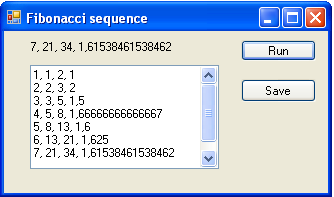uml-sp
Object-oriented simulation language UML2 SP
This project is maintained by vgurianov
Numerical and object models
Introduction
At now wide use numerical methods. In UML2 SP models, numerical calculation nearly use not. Model describe as an ontology but do not as differential equation. This is a distinctive feature of our approach. An ontology is alternative way of modeling. In this section we shall discuss it topic.
Measurements
Let us explain where the numerical values in object models come from. Consider the following example.
The Fibonacci sequence is a sequence of number when Fn = Fn-1 + Fn-2 with seed values F0 = F1 = 1,
i.e. any number is sum two previous numbers.
A numerical model in C# is
public void fbSequenceNumericalModel()
{
int fb0, fb1, fb;
fb0 = 1; fb1 = 1;
for (int i = 2; i<12; i++)
{
fb = fb0 + fb1;
probe = i.ToString() + ", " + fb.ToString()
fb0 = fb1; fb1 = fb;
}
},
where the probe variable is an output data.
An object model is following.
In the Fibonacci book, this sequence is result of growth of a rabbit population.
Let exist one pair of rabbits in start. Mating pair always produces one new pair at one month.
New pair grow one month and do not produces new pair. How many pairs will there be in one year?
Let Node class be model of pair of rabbits. A State attribute of Node is a state of the pair and has two values: mature state or childish state.
The pairs put to cages and the cages build in row. The previous and next attributes define place of cage to the row.
Let x and y be head of linked lists. The x attribute simulate sequence of months of year, the y simulate row of cages.
In constructor of Node defined initial data
y = new Node(); y.state = false;
y.next = new Node(); y.next.state = true;
We consider following algorithm
public void fbSequence()
{
Node ytmp;
if (t != null)
{
ix++;
Node yt = y;
int iy = 0; // mature couple of rabbits
int yy = 0; // all couple of rabbits
do
{
if (yt.state)
{
iy++; // count
ytmp = new Node(); ytmp.state = false;
// insert to head of list
ytmp.next = y; y = ytmp;
}
else { yt.state = true; };
yt = yt.next; yy++;
} while (yt != null);
t = t.next;
probe = ix.ToString() + ", " + iy.ToString() +
", " + yy.ToString() + ", " +
(Convert.ToDouble(iy)/Convert.ToDouble(last_y) ).ToString();
last_y = iy;
}
else probe = "The end";
},
where ix is counter of months, iy is counter of mature pairs, yy is counter of any pair, t is current node of x linked list. New node insert to head of linked list. The run result of the simulation is depicted in Fig.1

Figure 1. The Fibonacci sequence simulation
As we see, measurements of simulation give the Fibonacci sequence.
P.S. It is known that the Fibonacci sequence is closely related to the gold ratio phi = 1.618 …

In our opinion, the number of phi is often found in nature because it is the simplest non-trivial algorithm for constructing object structures.
Let us make the following important remark. Other data structures can be used to model the Fibonacci sequence. For example, a more compact and more elegant model can be created based on a binary tree. This implies that the simulation model requires the definition of additional assumptions. It can be said differently - the same mathematical model can describe different communication processes.
Summary: In object models, numerical data is result of measurements on object structures.
The simulation model in C# code:
Conclusion
In this section we discussed numerical and object models. In object models, numerical data is result of measurements on object structures. In object models, numerical calculations should be avoided because this violates the integrity of the ontology. However, for real models often have to use numerical calculations to reduce the complexity of the model.